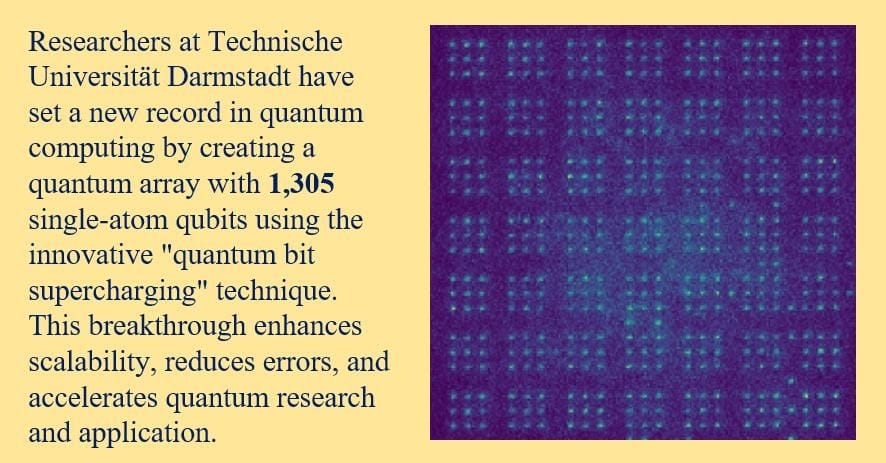Introduction
Quantum computing holds the promise of revolutionizing our approach to solving complex problems, offering exponential speedups over classical computing. This includes tasks such as decrypting RSA cryptography, simulating molecular structures, and optimizing large datasets. However, realizing this potential relies heavily on the number of qubits a quantum computer can effectively manage. Recent advancements have set a new milestone in the quantum realm: creating a quantum array with over 1,305 single-atom qubits using a novel technique called "quantum bit supercharging."
The Discovery
Researchers led by Professor Gerhard Birkl at Technische Universität Darmstadt have introduced a method called "quantum bit supercharging." This innovative approach has allowed them to assemble a quantum array comprising 1,305 single-atom qubits, surpassing previous records [1].
This quantum array is meticulously organized into defect-free structures with up to 441 qubits, overcoming the typical limitations posed by laser performance and control precision. Defect-free structures ensure higher performance and lower error rates in quantum computations. This advancement is crucial for practical applications of quantum computing.
The Significance
The new achievement is significant because it can:
- Enhance the computational power: With over 1,305 qubits, quantum computers can tackle a broader range of problems more efficiently. This includes advanced simulations in chemistry and material science, which are critical for drug discovery and the development of new materials.
- Accelerating quantum research: This milestone accelerates the overall progress in quantum research. It provides a robust platform for experimenting with more sophisticated quantum algorithms and error correction techniques, essential for building fault-tolerant quantum computers.
- Stimulate investment: Achieving such a high number of qubits can stimulate investments and advancements in quantum technologies. This can lead to the development of new industries and applications that harness the power of quantum computing.
Comparison with Superconducting and Trapped Ion Qubits
It's worth noting that while quantum bit supercharging has set a new high with 1,305 single-atom qubits, other technologies are also making significant strides:
- Superconducting Qubits: IBM's Condor quantum chip recently reached 1,121 qubits, demonstrating significant progress in superconducting qubit technology [2].
- Trapped Ion Qubits: Quantinuum has launched a 56-qubit trapped-ion quantum computer, setting a new benchmark for trapped ion qubits known for their high fidelity and coherence times [3].
Conclusion
The creation of a quantum array with over 1,305 single-atom qubits using quantum bit supercharging marks a pivotal moment in the journey towards scalable and practical quantum computing. This breakthrough not only showcases the advancements in quantum hardware but also sets the stage for future innovations that could transform numerous fields through unparalleled computational capabilities.
Reference
[1] Lars Pause et al., "Supercharged two-dimensional tweezer array with more than 1000 atomic qubits," Optica, 2024. DOI: 10.1364/OPTICA.513551.
[2] "IBM releases first-ever 1,000-qubit quantum chip," Nature, December 2023.
[3] "Quantinuum Launches Industry-First, Trapped-Ion 56-Qubit Quantum Computer," PR Newswire, June 2024.



Member discussion: